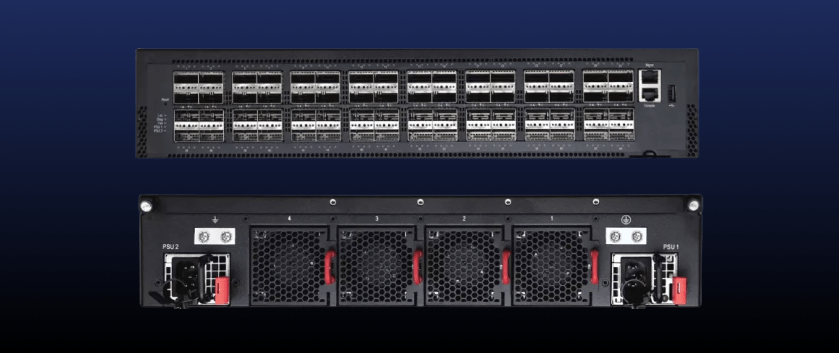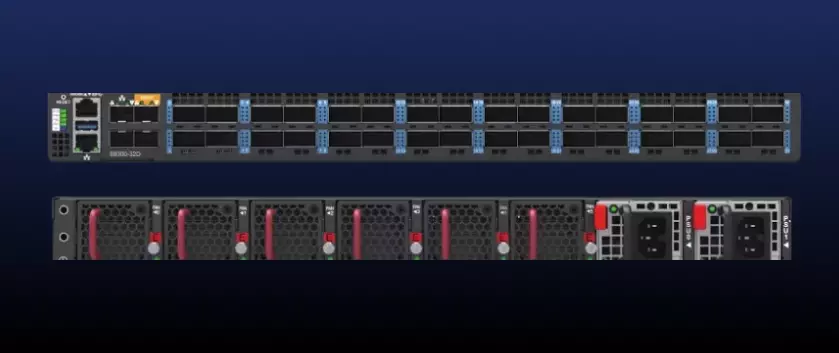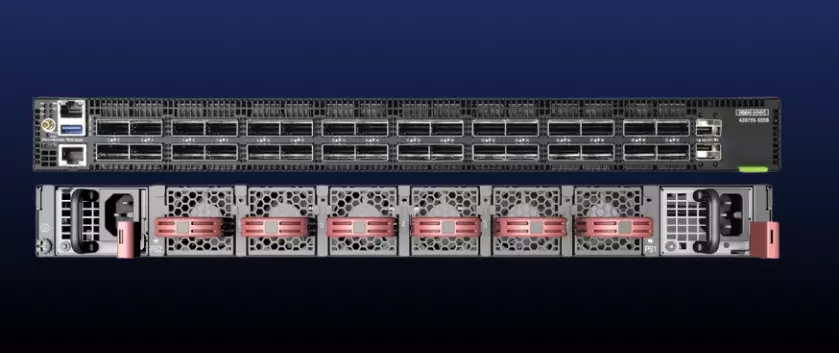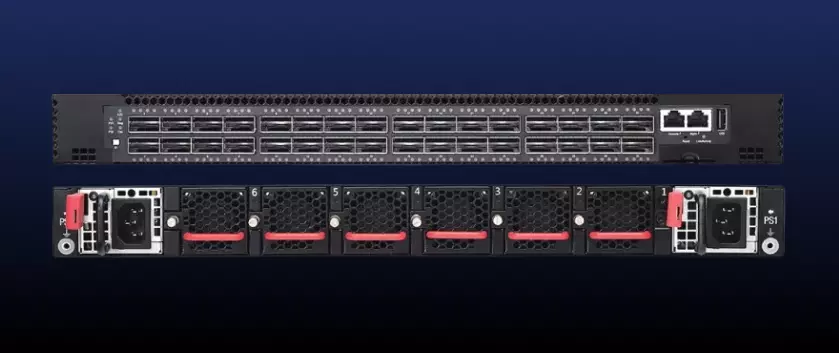Datacenter Networks
At network level, an agile and flexible service is required that allows layer 2 domains to be extended between different points in the datacenter or between different datacenters, avoiding loops and with a simple and scalable solution.
Disaggregated networks allow the deployment of architectures Spine & Leaf type, which will have the mission of:
- Transport of packages between ends: Includes hardware solutions and network protocols.
- High availability.
- Network convergence.
- End-to-end service definition of the network.
Switches WS-7816-64X
Switches WS-7726-32X
Switches WS-S9300-32D
Switches WS-9726-32DB
Switches WS-7712-32X
Switches WS-7816-64X

Open Design
- CPU: Intel Xeon D-1518 quad-core 2.2 GHz
- RAM: 8GB x 2 2133MHz with ECC (DDR4 SO-DIMM)
- SSD: 32 GB MLC
- Chipset: BCM56970 Tomahawk II
- 64x QSFP28 (40/100 Gbps)
- Breakdown:
- 4 x 10/25 Gbps
- 2 x 50 Gbps
- 1 x RJ-45 serial console
- 1 x RJ-45 1000BASE-T management
- 1 x USB Type A storage
- 48 x SFP+ each supporting 10 GbE or 1 GbE
- 6 x 100G QSFP28 each supporting 1 x 40/100 GbE
- Switching Capacity: 6.4 Tbps full duplex
- Forwarding Rate: 4.2 Bpps
Manufacturer:
- Edgecore
- Max 850W
- 2 redundant sources AC o DC
- 3+1 Hot-swappable 3 + 1 redundant fans
- Operating Temperature: 0° a 45° C
- Ventilation flows can be front-Back
- or Back-Front exchanging fans
- 2 RU 43.84 x 58.0 x 8.77 cm
- 14.1 Kg
Switches WS-7726-32X

Open Design
- CPU: Intel® Xeon® D-1518 processor quad-core 2.2 GHz
- RAM: DDR4 SO-DIMM 8 GB x 2
- SSD: 64 GB MLC
- Chipset: Broadcom BCM56870 Trident III 3.2 Tbps
- 32x QSFP28 (40/100 Gbps)
- Breakdown:
- 4 x 10/25 Gbps
- 2 x 50 Gbps
- 1 x RJ-45 serial console
- 1 x RJ-45 1000BASE-T management
- 2 x SFP+ 10G management ports
- 1 x USB Type A storage
- Switching Capacity: 6.4 Tbps full duplex
- Forwarding Rate: 2 Bpps
Manufacturer:
- Edgecore
- Máximo 550W
- 2 redundant sources AC o DC
- 3+1 Hot-swappable 3 + 1 redundant fans
- Operating Temperature: 0° a 45° C
- Ventilation flows can be front-Back
- or Back-Front exchanging fans
- 2 RU 43.84 x 58.0 x 8.77 cm
- 14.1 Kg
Switches WS-S9300-32D

Open Design
- CPU: Intel Skylake-D D-2145NT 8 Cores
- RAM: 2x16GB DDR4 R-DIMM with ECC support
- SSD: 1x128GB SSD
- Chipset: Broadcom Trident 4 BCM56880
- 32 x 400GE QSFP-DD service ports
- Breakdown:
- 4 x 100 Gbps
- 2 x 10GE SFP+ management ports
- 2 x10GE SFP+ OOB management ports
- 1 x 10/100/1000 RJ-45 management port
- 1 x RJ-45 serial console
- 1 x USB Type A storage
- Switching Capacity: 12.8 Tbps full duplex
- Forwarding Rate: 5228.8 Mpps
Manufacturer:
- Ufispace
- Max 1300W
- 2 redundant sources AC o DC
- 5+1 Hot-swappable 5 + 1 redundant fans
- Operating Temperature: 0° a 40° C.
- 1 RU 436 x 645 x 44.0 mm
- 29 Kg
Switches WS-9726-32DB

Open Design
- CPU: Intel® Pentium® Processor D1519 4-cores 1.5 GHz
- RAM: 2x8GB DDR4 SO-DIMM with ECC support
- SSD: 2x64GB SSD MLC
- Chipset: BCM56880 Trident 4 12.8 Tb/s
- 32 x QSFP56-DD 400 GbE
- Breakdown:
- 4 x 100 Gbps
- 1 x RJ-45 serial console
- 1 x Micro USB console port
- 1 x RJ-45 1000BASE-T management
- 2 x SFP+ 10G management
- 1 x USB 3.0 storage port
- Switching Capacity: 25.6 Tbps full duplex
- Forwarding Rate: 5.4 Bpps
Manufacturer:
- Edgecore
- Max 1300W
- 2 redundant sources AC o DC
- 5+1 Hot-swappable 5 + 1 redundant fans
- Operating Temperature: 0° a 45° C
- 1 RU 438.4 x 590 x 43.5 mm
- 11.85 Kg
Switches WS-7712-32X

Open Design
- CPU:Intel® Atom® C2538 quad-core 2.4 GHz x86 processor
- RAM: DDR3 SO-DIMM 8 GB x 2
- SSD: 64 GB MLC
- Chipset: Broadcom BCM56960 Tomahawk 3.2 Tbps
Doors:
- 32x QSFP28 (40/100 Gbps)
- Breakdown:
- 4 x 10/25 Gbps
- 2 x 50 Gbps
Management:
- 1 x RJ-45 serial console
- 1 x RJ-45 100/1000BASE-T management
- 1 x USB Type A storage
Performance:
- Switching Capacity: 6.4 Tbps full duplex
- Forwarding Rate: 3.2 Bpps
Manufacturer:
- Edgecore
- Delta
Power:
- Max 550W
- 2 redundant sources AC o DC
Ventilation
- 5+1 Hot-swappable 5 + 1 redundant fans
- Operating Temperature: 0° a 45° C
Physical characteristics:
- 1 RU 43.84 x 51.5 x 4.35 cm
- 10.87 Kg
*Pictures obtained from www.edegcore.com